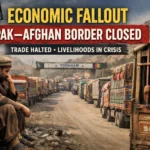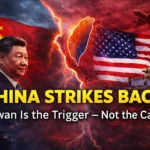Former U.S. President Donald Trump’s decision to slap a 50% import tariff on Indian goods has triggered shockwaves in both Washington and New Delhi. While the White House officially cites trade imbalance and unfair tariffs as the main reasons, many policy insiders and analysts point to a deeper motive — India’s thriving trade in discounted Russian oil.
Why the Tariff Really Happened
1. The Russia–India Oil Link

Since the Ukraine conflict began, India has rapidly climbed to become Russia’s second-largest crude oil customer, at times even overtaking China. It buys heavily discounted Russian crude, refines it in domestic facilities, and then re-exports refined fuel to markets in Europe and the United States effectively giving Moscow a backdoor to bypass Western sanctions.
Under Trump’s revived “America First” energy policy, such practices are viewed as direct economic sabotage.
“We are not going to let countries profit from aggression while undercutting American sanctions,” said a senior Trump adviser in an off-record briefing.
Analyst View:
This move isn’t just about import–export numbers — it’s an economic pressure tactic intended to:
-
Punish India for circumventing sanctions on Russia.
-
Warn other neutral states that non-alignment has consequences.
-
Push New Delhi back toward the Western geopolitical orbit.
It mirrors Trump’s earlier approach with China (2018–2020), where tariffs were used as both trade tools and political leverage.
2. Trade Deficit Is a Factor — But Not the Main One
-
India enjoys a $40+ billion trade surplus with the U.S.
-
High Indian tariffs on certain U.S. goods — from Harley-Davidson motorcycles to apples — have long irritated Washington.
-
Trump has repeatedly called for reciprocal tariffs, claiming America should match other countries’ rates.
Still, insiders suggest Russian oil is the real red line, and the trade imbalance is more of a convenient justification.
3. Political Messaging in an Election Cycle
The tariff decision also plays well domestically for Trump:
-
Reinforces his “tough on freeloaders” narrative.
-
Appeals to U.S. oil producers who resent India’s access to cheap Russian crude.
-
Offers a headline-friendly foreign policy stance for his 2026 campaign trail.
Implications for India and the World
1. Economic Hit to Indian Exports
The U.S. is India’s single largest export market. Sectors likely to be hit hardest include:
-
Jewelry and textiles
-
Pharmaceuticals and IT services
-
Auto parts and machinery
A sudden 50% tariff could cause billions in lost revenue and damage India’s competitiveness.
2. Retaliation from New Delhi
India could respond by:
-
Increasing tariffs on U.S. agricultural goods like almonds and soybeans.
-
Targeting Boeing aircraft sales or restricting tech imports.
-
Expanding trade within BRICS using local currencies to bypass the U.S. dollar.
3. Supply Chain Disruptions
For the U.S., the move isn’t cost-free:
-
40% of generic drugs in the U.S. originate from India, meaning higher medicine prices.
-
Automotive and electronics supply chains could slow down.
-
Everyday consumer goods — from clothing to spices — may become more expensive.
4. Diplomatic Fallout
Strategically, this decision risks:
-
Straining the QUAD alliance (U.S.–India–Japan–Australia).
-
Pushing India closer to Russia, Iran, and China.
-
Weakening U.S. influence in the Indo-Pacific while empowering rival blocs.
Is This Really About Oil?
In short — yes.
The tariff serves as a geo-economic penalty, aiming to:
-
Force India to take a clear side in the global order.
-
Reduce its deepening energy ties with Russia.
-
Send a warning to other nations considering similar “neutral” trade strategies.
The Road Ahead for India
India faces a stark choice:
-
Continue buying cheap Russian oil and risk a prolonged economic standoff with Washington.
-
Or step back from Moscow, sacrificing energy flexibility to restore trade harmony with the U.S.
Either way, Trump has made one thing clear — in his foreign policy world, neutrality comes at a steep price.









